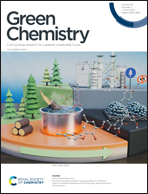Cu-catalysed Chan–Lam synthesis of unsymmetrical aryl chalcogenides under aqueous micellar conditions†
Abstract
A mild Cu-catalysed Chan–Lam protocol has been developed for the synthesis of unsymmetrical aryl chalcogenides, including selenides and sulfides, in an aqueous micellar medium. The catalytic system consists of a CuBr catalyst, a PEG2000-functionalized pyridine triazole water-soluble ligand, a sodium dodecyl sulfate surfactant, and air as the terminal oxidant. A diverse variety of diorganyl diselenides/disulfides could be coupled with various aryl, heteroaryl, and styryl boronic acids in water at ambient temperature to afford the corresponding aryl chalcogenide products in good to excellent yields. After isolating the products via extraction with methyl tertiary-butyl ether, the remaining aqueous phase can be recycled at least seven times by charging an additional half catalytic amount of CuBr during each subsequent cycle. UV-VIS spectral studies revealed that sodium dodecyl sulfate enables the aqueous solubility of both the hydrophobic diorganyl diselenides/disulfides and the hydrophilic arylboronic acids. Transmission electron microscopy studies showed that a large number of nanomicelles with diameters of 31.9 ± 8.7 nm (for synthesis of the selenides) and 26.6 ± 5.0 nm (for synthesis of the sulfides) were formed under the reaction conditions.



 Please wait while we load your content...
Please wait while we load your content...